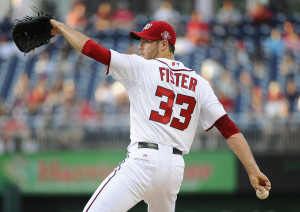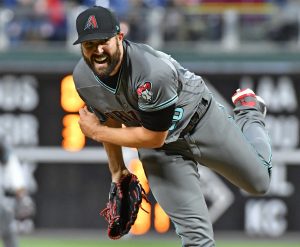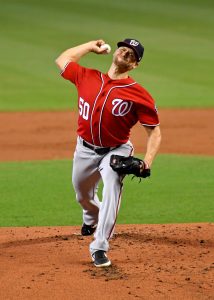For those in the Mid-Atlantic, the Nationals and Astros road warrior World Series is airing on MASN this week. For the rest of us, the 7-game battle has hardly disappeared from memory, as it remains the most recent non-exhibition game played in Major League Baseball. Still, when a player steps up his game on the biggest stage and raises his profile like Howie Kendrick did last fall, it’s hard not to look back early and often to re-live the heroics.
Strictly by definition, Kendrick wasn’t even an “everyday player” for the Nationals last season. Coming off an achilles injury and playing in his age-35 season, manager Dave Martinez was rigid about giving Kendrick enough rest to keep him fresh throughout the season. No matter the volume of clamor from Nationals fans, Martinez refused to deploy Kendrick indiscriminately, starting him in only 70 of the team’s 162 games (with liberal usage off the bench). Kendrick was the designated hitter of choice for Martinez in 7 of 10 interleague road games, and he also called upon Kendrick 41 times as a pinch-hitter.
While Kendrick found himself on the bench more often than not, he still added value as a versatile defender. Of the games he did start, 35 came at first base, 18 at second, and 10 at third. Unlike years past, Kendrick wasn’t utilized in the outfield, but it’s hard to know if that was a strategic decision made to shelter Kendrick. The Nats simply had no need to deploy him in the grass having gotten uncharacteristically stable play from their trio of outfielders. Juan Soto started 147 games in left, Victor Robles made 147 starts between center and right, and even the previously-fragile Adam Eaton made 143 outfield starts in 2019 (his most since 2016).
Whatever the reason, it’s hard to knock the Nationals’ prudent use of Kendrick. Not only did he stay healthy, but he came through time and time again, finishing with an otherworldly slash line of .344/.395/.572 across 370 plate appearances. If baseball had a sixth man award, it would be intended to spotlight a season exactly like Kendrick’s 2019. He was Lou Williams: high-energy, low-maintenance, instant offense off the bench.
And like Williams, Truck could close. Without a true sixth man award, Kendrick took the postseason as his opportunity to shine. It’s hard to imagine a player of Kendrick’s pedigree seizing quite so many opportunities for heroics in a single postseason (I see your hand, David Freese, but I’m not calling on you). As in his career on the whole, Kendrick wasn’t perfect. He made a couple of errors, looked foolish on the bases at times and finished the postseason with a slash line (.286/.328/.444) that one could easily overlook.
But in terms of peak value, Kendrick made his hits count. First, there was the series-winning, 10th-inning grand slam in the winner-take-all game five to vanquish the Dodgers. Considering this was just the Nationals second win in a winner-take-all-game in their history (coming a week after their first), Kendrick’s grand slam was, at the time, no doubt the biggest hit in Nationals’ team history. No longer could the Nats be shrugged aside as a franchise without a postseason series win (Mets fans on Twitter will have to find something new). With a history as long and storied as baseball’s, it’s rare these days to have the opportunity to watch in-real-time as moments exists in a self-actualized vacuum wherein each big hit instantly supplants its prior as the biggest in team history – but that was the case for the Nats this postseason, and Kendrick was the guy who kept outbidding himself with greater and greater moments.
Kendrick didn’t get that scene-stealing moment in the NLCS, but he did capture MVP honors by hitting .333/.412/.600 with four doubles. Kendrick was great against the Cardinals, but let’s be clear, he was not the most valuable piece of the Nats’ NLCS puzzle. That would be the starting pitchers, who didn’t allow an earned run until game four, yielding just 7 hits across those three games while striking out 28. When everyone is an ace, no one is an ace, so Kendrick took home the hardware for continuing to put together quality at-bats and driving home important runs.
But there’s no such thing as a transcendent playoff performance that doesn’t include the World Series. Pitching again took centerstage for the Nats, especially as the bats went ice-cold at home. The Nats scored just one run apiece in each of their home games, taking the L in all three. Kendrick went one-for-eight at home while only starting in games four and five. He had a good game two in Houston, but it was a relatively punchless series for Kendrick by the time he came to the dish in the top of the seventh inning of game 7, his club trailing by one. Kendrick’s biggest moment of the postseason – of his career – gave the Nats their fifth come-from-behind victory of the playoffs – the most ever – and it solidified his place in the baseball canon.
What made Kendrick’s postseason play so impressive, really, was how late it came it a good-but-not-great career. The bulk of Howie’s career took place on good-but-not-great Angels teams that, like Kendrick himself, were often quite good, but failed to make a lasting impact on the baseball landscape.
Kendrick himself went from productive regular to bench contributor for the Dodgers and Phillies before making his way to Washington. Now, you’ll be hard-pressed to find an announcer in the game who hasn’t referred to Kendrick as a “professional hitter.” To their collective credit, they’re not wrong. Kendrick is a career .294 batter who consistently puts the bat on the ball, never striking out in more than 20.4% of his plate appearances. Most seasons his strikeout rate hovers around 16-17%, though in 2019 he was even better, striking out a career-low 13.2% of the time.
Kendrick can hit, but that’s far and away his best skill. His 9.2% walk rate in 2016 with the Dodgers was easily a career-high. His career rate is 5.4%. He runs okay, but not great, notching double-digit stolen bases in 8 different seasons, but never more than 14, a high he reached four times. Generally speaking, he’s about a 14-stolen-bases level defender as well, sure-handed as a second baseman, but never threatening as a top shelf defender. Power-wise, his career .137 ISO leaves a lot to be desired, but he hit for just enough power to leverage the rest of his skillset. He was an All-Star once (2011) when he finished with 4.6 bWAR, and his “best season” earned him an 18-spot in MVP voting. That came in 2014, his last with the Angels, when he put up 6.1 bWAR/4.6 fWAR, which is impressive considering it was one of his worst power outputs, finishing .293/.347/.397 with just 7 home runs.
But in 2019 everything clicked for Kendrick. He managed 17 home runs while easily notching career highs in many rate metrics (ie, .228 ISO, 146 wRC+). Before last season, he’d never been more than 23% better than league average. But achilles surgery clearly agrees with Kendrick, because at age-35, not only was he 46% better than average, but he put a bow on his career year with the final game-winning hit of the season. More than any award, that’s the type of thing baseball remembers.



